The Mystery Behind The Divine Masculine And Feminine Revealed
What are the divine masculine and feminine?
The divine masculine is the principle that represents our connection with the part of our consciousness that is responsible for logic and reasoning, protectiveness, strength, action, and giving, regardless of gender.
The divine feminine is the principle that represents our connection with the part of consciousness that is responsible for empathy, intuition, nurturing, sensuality, receptivity, and collaboration, regardless of gender.
The divine feminine and divine masculine are another way of differentiating the energies of receiving and giving, allowing and acting upon, feeling and thinking, and so on.
We all have the masculine and feminine within us.
The key is to balance them out so we can achieve harmony in our life. Each side supports the other side in a unique way.
Imbalance occurs due to the complex psychological and emotional mesh of previous experiences and the things we learned while growing up.

Everything we are taught (about gender, appropriate behavior, expectations, and so on) influences us later on in life.
Some parts of ourselves can be either stagnant or overactive.
For example, boys are brought up to suppress their feminine qualities such as creativity, expressing emotions, and intuition.
On the other hand, girls are taught they should always let someone else lead, be less ambitious, and never question anything.
Traditionally, the left side of the brain is considered to be more logical while the right side is considered to be more involved in emotional processing.
That’s why masculine qualities are connected to verbal expression and to analytical, systematic, and abstract types of thinking.
Additionally, that’s why female qualities are connected to non-verbal, relational, subjective, and sensory and concrete rather than abstract types of thinking.

The truth is, none of these characteristics are enough on their own – that’s why balance is the most important thing of all.
However, before balancing energies we need to accept both parts of us, especially the part that’s predominant.
If we feel feminine – we need to accept our femininity fully.
That sometimes means accepting things that are outside the norm; sometimes it means accepting something that’s way ahead of the time or alarmingly traditional for other people.
It’s the same thing for masculinity.
The point of everything is not to go against one’s inner feelings.
Our soul is always fully aware of what we need to do; it’s only our mind that keeps blabbing and causing uncalled fear.
But before anything, we need to understand why we need male and female energy and how their interaction works.
Why are male and female seen as opposites?
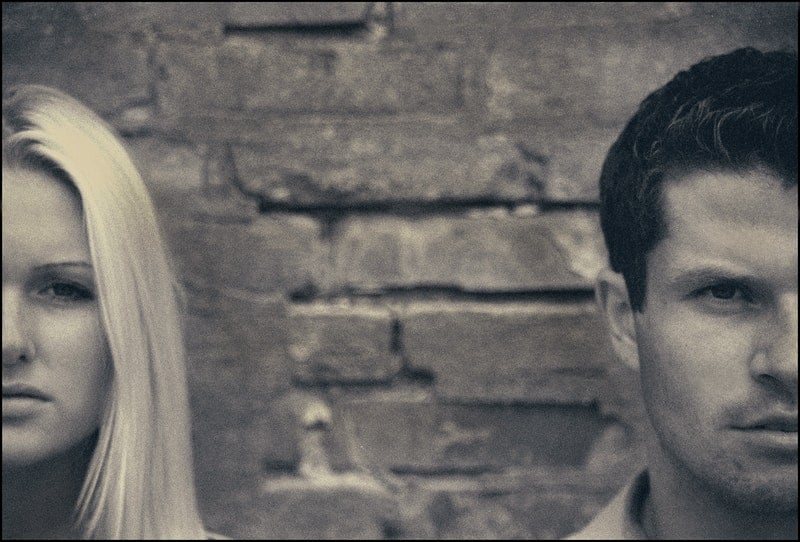
“The union of feminine and masculine energies within the individual is the basis of all creation.” – Shakti Gawain
According to many old philosophical and religious teachings, Universal Intelligence (order of the universe) was born from the duality of polarisation, described as male and female principles.
That resulted in harmony, activity, and inertia, which enabled the world to exist as it is.
Symbolically, a male and a female in a sexual embrace depict the striving for the unification of separate aspects into the greater consciousness, which is whole.
This same concept can be used to describe our own personal unity of male and female principles within ourselves. In other words, it can be used to depict our own sense of completion as a human being.
The whole of creation is the result of the interaction of the masculine and feminine principles.

The divine feminine and masculine principles reflect the two creative principles of the cosmos: God the Father and Goddess the Mother, of which men and women are the reflections.
The two principles must work together because on their own they’re not complete, they’re lacking.
When we look only at the surface, on a physical level, it’s easy to differentiate the male body from the female body in human beings.
They both have recognizable features that make them look feminine or masculine.
However, from a non-physical point of view, it’s not that easy: As I said before, every person possesses both the masculine and feminine within them.
That’s why it’s not necessarily good to think of them as separate because the goal is the unification of the principles that work together rather than promoting their separateness.
The power of divine masculine energy

“The stronger a man is, the more gentle he can afford to be.” – Elbert Hubbard
Divine masculine energy is the highest expression of the masculine principle. It manifests through thoughts, actions, and belief systems.
The archetypal male principle uses rationality, logic, strength, and exudes leadership skills.
The common error is to think that the divine masculine is possessed only by men.
When we look at society, we can clearly see that the whole world possesses masculine elements – from people of different genders to the world as a universal frame.
The world was built with the help of traditionally masculine traits.
Without masculine traits such as logic and strength, we would never make any kind of progress. Can you imagine the world without those characteristics?
It would be total chaos and bare survival.
However, every masculine trait can be balanced and imbalanced.
What that means is that too much logic and rationality can make a person blind to the benefits of a more creative approach to solving problems.

The affectionate, emotional side of humans can’t be ignored, especially if we’re on the path of unity.
Also, strength can be used for protection and providing but it can also be used for terror and violence.
Sometimes assertiveness is necessary and sometimes is just a superficial and ego-driven need.
It all depends on emotional maturity and willingness to do the inner work. It’s possible to be confident without being arrogant and to be adventurous but not reckless.
With power and strength comes the opportunity to use them for selfish reasons.
It’s interesting that most religious books were written by and for men.
In a sense, some religions are symbolically more masculine in nature because they follow rules, bring order, and they’re more solar in nature.
Of course, that’s not to say that religion doesn’t have a divine feminine aspect as well, it’s just not as pronounced or visible.
Usually, religious traditions amplify some kind of restrictions, such as refraining from sexual activities, fasting, etc. – all of which demand self-control.
Control is a big part of the masculine path. Since men are bearers of the active force and since they produce, generate, and direct energy – they have to have control over it.

Directionless energy is destructive towards the man himself and everybody and everything around him. Why? Since producing and generating energy demands strength, it’s easy to exhaust it.
If precious energy is just mindlessly directed towards things that don’t reflect it back, in a sense it’s beneficial to no one.
Healthy masculine energy is seen through men who use their innate masculine traits such as logic and strength in a gentle and mindful way.
The greatest thing of all is to have power and not use it to enslave someone else. It’s the ultimate goal of the self-control that’s needed to achieve the height of the divine masculine.
When our inner divine is purified, we don’t need praise or somebody to stroke our ego. We’re content with ourselves, and we honor ourselves and other beings.
A man who awakens the divine masculine within makes his partner feel safe and supported in every possible way and that’s what feminine principle craves.
Interaction between male and female principles can be symbolically illustrated by the Shiva and Shakti.
Shiva is the state of being unmoved by pain and the external world, and represents direction, freedom, and purpose.
Shakti, on the other hand, is the freedom to become, it’s flow, creativity, and endless openness to possibility.
The power of divine feminine energy
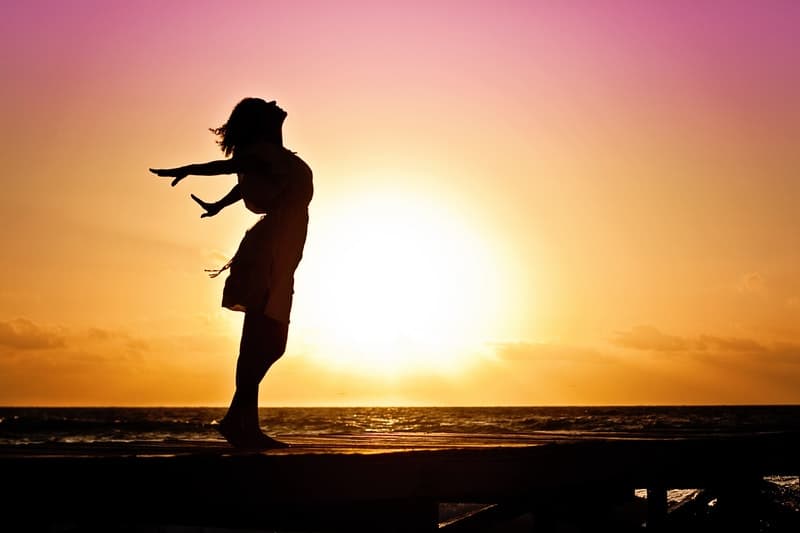
“Who is She? She is your power, your Feminine source. Big Mama. The Goddess. The Great Mystery. The web-weaver. The life force.” – Lucy H. Pearce
The divine feminine is the highest expression of the feminine principle.
The archetypal female principle uses emotions, creativity, nurturing, and exudes magnetism.
Unfortunately, through history, the female principle was oppressed and looked down upon.
Since material progress has always been more visible than any other (for example, emotional) – female traits have been shunned for the sake of male traits because they are more obvious and ”useful”.
Not only that, but women’s natural magnetic energy has always represented a challenge for much-needed male self-control.
Instead of challenging themselves, men choose to restrict women.
That’s resulted in all the incredibly sad parts of our history. The consequences are visible even today.

However, today we’re moving towards rediscovering the divine feminine.
Both men and women are called to empower and protect the divine feminine.
Just like men’s, women’s characteristics and traits also have their plus and minus sides. It all depends on balance.
For example, a woman’s energy is accommodating but at the same time, it can also make her very passive and easily influenced.
Another downfall of an overly passive nature is not being direct. Women have been forced to use less direct ways to achieve their goals.
That’s where the famous stereotype of the passive-aggressive woman stems from and this is why it’s understandable.
The other things that can go wrong with an imbalance of traditionally feminine traits are, for example, uncontrolled emotions, and an over-amplified need for comfort and safety that can sometimes immobilize a person.
All of these things can be regulated through self-awareness.
Healthy feminine energy is always kind, generous, wise, and supportive of others. It allows others to comfortably be themselves and it’s not restrictive in a negative sense.
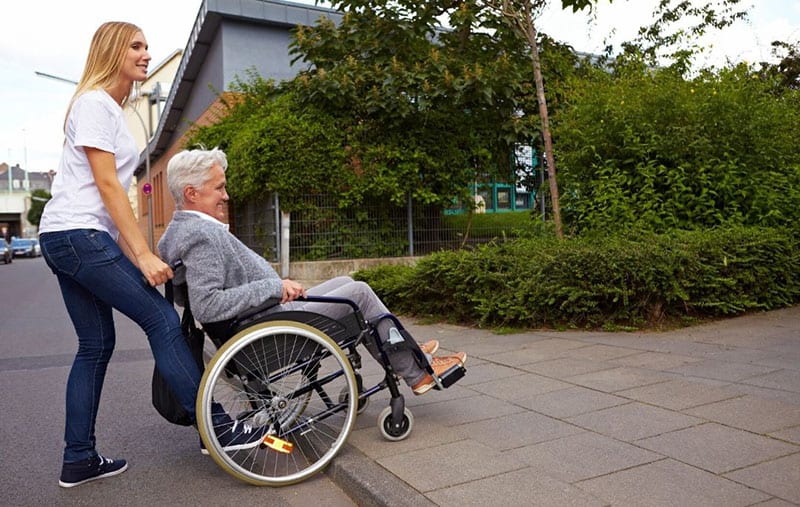
It’s capable of creating almost magical things (because it follows intuition) and providing constant well-being for others (nurture).
As opposed to men, women do not need restrictions in a sexual and sensory self for they are more sensual in their nature; they need to let go of their innate restrictions and allow the energy to enter them.
It goes without saying that ”allowing” means allowing exclusively with healthy boundaries and a partner who understands them.
Unfortunately, most of the spiritual texts do not have teaching for the female principle.
That’s why the primary source for women’s education on the matter were stories, fairy tales, legends, and similar things with a more symbolic approach.
While the male principle is the bearer of energy, the feminine principle is what gives shapes to everything.
Male is energy, the feminine is matter. Together, they make a reality, a universe, a perfect balance.
Nothing can be conceived without male energy and nothing can be given birth to without feminine energy.
The divine masculine and divine feminine are dependent on each other.
The symbolism of yin and yang
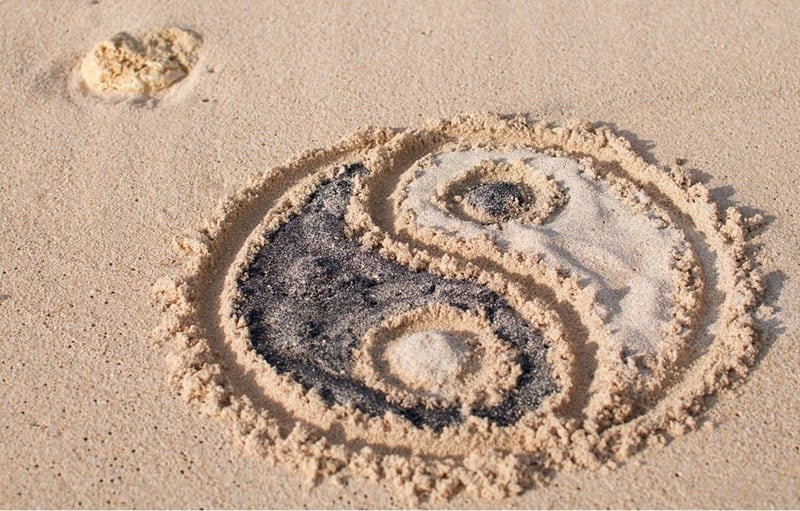
“The dance between darkness and light will always remain – the stars and the moon will always need the darkness to be seen, the darkness will just not be worth having without the moon and the stars.” – C. JoyBell C.
The yin/yang symbol is part of Taoist philosophy.
When we read and talk about male and female energies, we often hear about yin and yang. Moreover, we can often see someone described as more yin or more yang.
What is their symbolism?
When we back away from the aggressive media images that promote nothing but the separation between the two principles by either overly differentiating them or overly equalizing them, and take a deeper look into ourselves, this is what we see:
Human beings are made from opposing forces. The interaction of opposing forces is how things move, not only within human beings but in general.
The symbol of yin and yang is a circle (eternity and infinity), with the black part (yin part) representing the female principle and the white part (yang part) representing the male principle.
Inside the white part, there’s a black dot, and inside the white part, there’s a black dot.
What this represents is achieving balance. It represents the need for that which is different from us to complete us. It also represents that we’re never fully just one principle.
One principle is not enough on its own. It can’t reach its purpose.
To better understand yin and yang, and also the female and male innate nature, here’s more symbolism they represent:
Yin symbolizes night, moon, chaos, the negative, the passive, water, earth, intuition, sleep, cold, structure.
Yang symbolizes day, sun, order, the positive, the active, fire, intellect, vigor, function.
Healing the divine masculine and feminine

“No act loses us; no violence we’re subjected to destroys us; no debasement chases out the divine, and no one can take the divine from us.” – Daniel Odier
How can one heal an imbalanced divine masculine and feminine?
Divine energy always exists. The thing is we need to purify our intention and approach through inner work to attain it.
In today’s world, there are many theories on how to approach healing. Some promote self-love while others emphasize responsibility.
Either way, the most important thing is to be self-aware and to have unconditional love.
Unconditional love means understanding everything as it is. There’s no right or wrong. There’s no terror of separation.
The biggest obstacle in the process of healing is the illusion of separation. That’s what causes pain and unhappiness.

Separation is especially emphasized to the two genders. It’s almost as if they are at war with each other.
This idea in itself is so bizarre, but what’s even more bizarre is how widespread and accepted it is.
How can we be separated from something we literally can’t live without?
The key is to have the humility to admit it and see the divine in the other, even when they’re not perfect.
Every case of healing is different and requires different healing sessions. Everything is individual and every human who listens to intuition can find the best way to heal themselves.
All they need is bravery and determination.
The path to wholeness

“In every atom, there is a reflection of the whole.” – Jay Woodman
One of the lessons in this life is obviously learning the meaning of being ourselves and exploring what we are.
That includes our gender and it’s characteristics. Our personal measure of yin and yang within ourselves.
We shouldn’t get too caught up in figuring out how to increase and decrease this or that but rather listen to our own being, our own needs, and try to live in accordance with our will and our heart.
As we already mentioned, the divine masculine is portrayed as courageous, as the energy of action and power, while the feminine energy is flexible and patient and wise.
The point is not what they symbolize separately, but what they’re capable of creating together with their given traits.
It’s honoring the best in both, first in ourselves and then in the others around us.

We have the opportunity to get a closer look at what we think the opposite of us is – within ourselves! Isn’t that amazing?
If you feel like a predominantly yin person – try to engage in some of the yang activities that you feel you lack. Learn the cause of your own imbalance.
The same goes for a predominantly yang person who wants to work on their yin qualities.
Generally speaking, women have a harder time losing control and letting go while men have a hard time connecting to their heart and emotions.
Not all of us are universally advanced in what is supposed to be their innate quality based on gender, and that’s fine.
It’s important to have a goal to strive for. Understanding ourselves on every level is what’s going to bring us closer to the goal.
What’s interesting is that usually when we make peace with ourselves we make room for our divine partner or twin flame to enter our life.
That’s how we need to act in order to do something extraordinary. We need to nurture our strengths and work on our weaknesses. We need to evolve and grow constantly.
Where to start?
1. Make peace with your femininity/masculinity

With so many different things we hear about our gender through life, it’s easy to be confused or even disappointed with our own gender.
Harmful doctrines throughout history have made us anxious to just feel things spontaneously, without fear we’re doing something wrong or socially unacceptable.
Reexamine everything you’ve heard in life and try to think about it for yourself.
Do you reject some part of yourself because you think it’s weak? Do you wish you were more or less ambitious?
Are you afraid to admit you’re more attracted to certain things than others even if that’s not preferable?
The truth is, we need to be completely honest with ourselves and take a step to change things we don’t like – even if we’re afraid to do it.
So many women reject their feminine side because they’ve learned to compete for a place in a man’s world.
They avoid expressing their emotions and vulnerability for the fear of being seen as too weak.

At the same time, they’re bombarded with ideas and images of what women should look like, and it’s usually overtly feminine (or sexual which again emphasizes the feminine shape).
It’s the same thing for men but with less emphasis on the looks. So many men never express their innermost feelings for the same fear of appearing weak before others.
They’re expected to be fully emotionally functional – even though they were never given the right emotional support.
On top of that, they’re expected to always know what to do and act like a real man.
Nothing ever happens without accepting things and then letting them go. That’s how we make space for action and allow for things to change.
In other words, if we want to be better, we need to change.
Accept your femininity and masculinity to reach your divine masculine and feminine.
2. Practice mindfulness
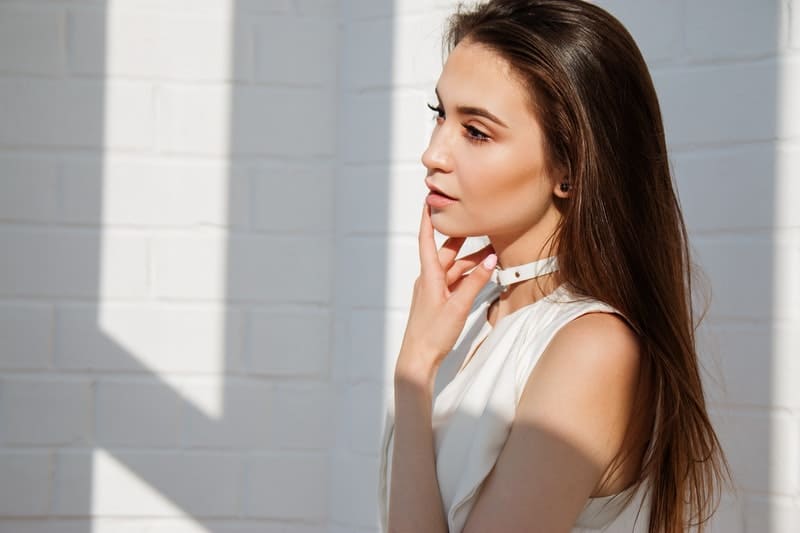
To practice mindfulness means to simply observe your thoughts more frequently – if possible, always.
The point of mindfulness is to catch yourself when you’re thinking a thought that promotes negative beliefs about yourself and others.
It sounds easy, but in reality, it’s really quite hard to do. Try it and see for yourself.
The second we start observing our mind we notice how busy it actually is.
The goal is to put thought into everything we do and to connect with our bodies. That way, we train our intuition and give attention to ourselves and our needs.







